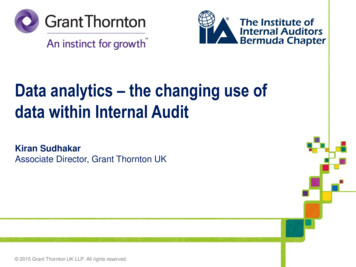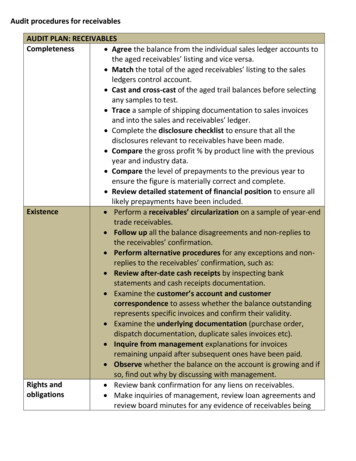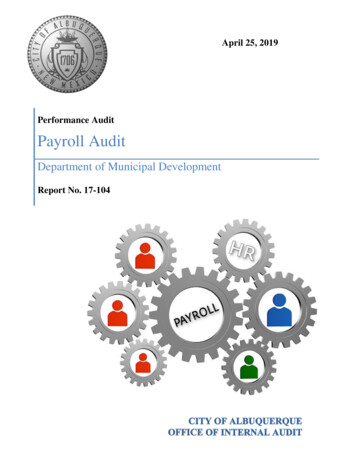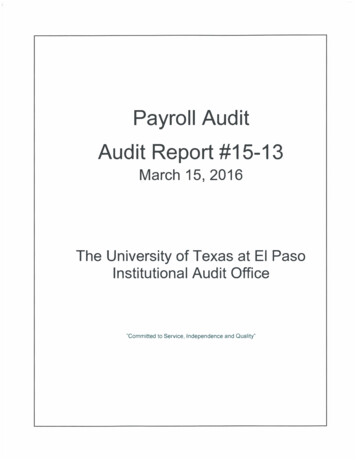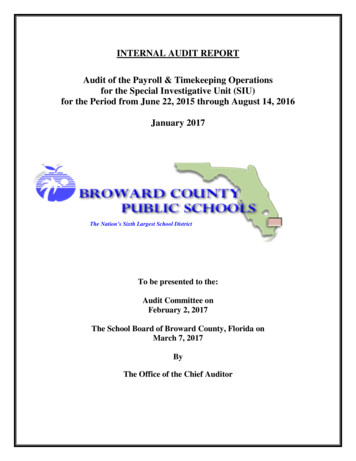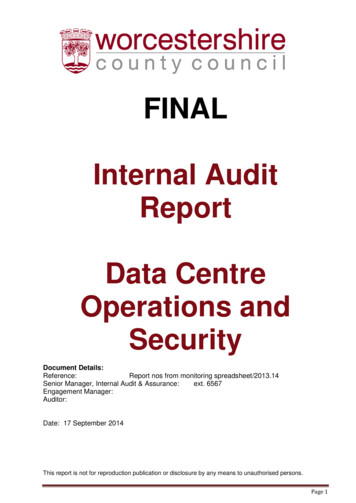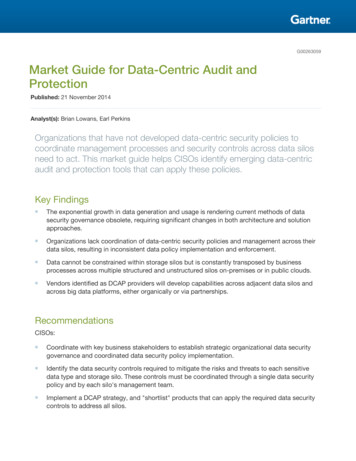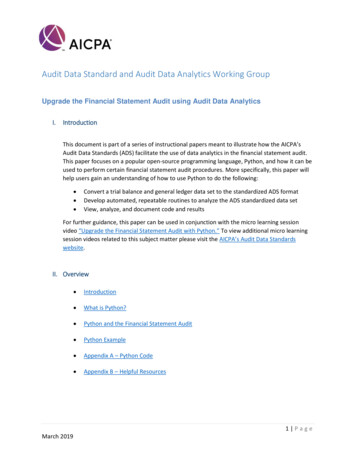
Transcription
Audit Data Standard and Audit Data Analytics Working GroupUpgrade the Financial Statement Audit using Audit Data AnalyticsI.IntroductionThis document is part of a series of instructional papers meant to illustrate how the AICPA’sAudit Data Standards (ADS) facilitate the use of data analytics in the financial statement audit.This paper focuses on a popular open-source programming language, Python, and how it can beused to perform certain financial statement audit procedures. More specifically, this paper willhelp users gain an understanding of how to use Python to do the following: Convert a trial balance and general ledger data set to the standardized ADS formatDevelop automated, repeatable routines to analyze the ADS standardized data setView, analyze, and document code and resultsFor further guidance, this paper can be used in conjunction with the micro learning sessionvideo “Upgrade the Financial Statement Audit with Python.” To view additional micro learningsession videos related to this subject matter please visit the AICPA’s Audit Data Standardswebsite.II. Overview Introduction What is Python? Python and the Financial Statement Audit Python Example Appendix A – Python Code Appendix B – Helpful Resources1 PageMarch 2019
III. What is Python?Python is an open-source programming language that was first released in 1991; in other words,the original source code is freely available and can be modified or redistributed. It’s available fora variety of operating systems and can be used for general-purpose programming for both largeand small projects. Python’s simple coding style makes it the preferred language for thosebeginning to learn how to code.Python supports many programming paradigms such as imperative, functional, and procedural.Programming paradigms are ways to classify programming languages based on their features.1Common paradigms2 include the following: Imperative — allows side effectsObject-oriented — groups code together with the state the code modifiesProcedural — groups code into functionsDeclarative — does not state the order in which operations executeFunctional — disallows side effectsLogic — has a particular style of execution model coupled to a particular style ofsyntax and grammarSymbolic programming — has a particular style of syntax and grammarPython can be used in many different areas and throughout many different industries such asdata science, web development, finance, accounting and auditing, molecular biology, andapplication security. Specific uses include the following: Data engineering – Cleansing data, structuring data, and loading dataAnalytics – AI, text mining, visualizationsAutomation – Extract, transform, load (ETL), conversion, and reportingPython also can be used to create or interact with web applications as part of web developmentor micro services. For the purpose of this paper, we will focus on the use of Python in thefinancial statement audit.IV. Python and the Financial Statement AuditThere are a wide variety of uses for Python. When it comes to the financial statement audit,Python can help with extracting, transforming (or formatting) and loading data, as well astesting and analyzing the data and developing visualizations to help view and document results.Subsequent sections will walk through an example of how Python can be used for extractingdata and transforming it into the ADS standardized format, loading the standardized data, anddeveloping code to further analyze the ADS standardized data set.1https://en.wikipedia.org/wiki/Programming paradigm2 PageMarch 2019
V. Python ExampleThis section will walk through the process of using Python to (1) apply the ADS format to an SAPtest data set and (2) develop code to further analyze the ADS standardized data set (performjournal entry testing procedures). As stated previously, this paper can be used in conjunctionwith the micro session video, “Upgrade the Financial Statement Audit with Python.” Please notethat the routines developed here can be used on any ADS standardized data set and can beaccessed on the AICPA’s Audit Data Standards webpage.Applying the AICPA’s Audit Data Standard FormatAs this example focuses on journal entry test work, the AICPA’s general ledger ADS format wasused and applied to an SAP test data set. The full audit data standard document can be accessedon the AICPA’s Audit Data Standard website.As a first step, the high-level mapping, discussed in the micro learning session “Introduction tothe Audit Data Standards” and shown in figure 1, was used to develop Python code to load theSAP test data set and apply the general ledger ADS format. This mapping is important becausethe field names identified in figure 1 were used within the Python code to help identify the fieldswithin the SAP test data set that would need to be reformatted.3 PageMarch 2019
Figure 1 – High-Level Mapping of ADS Field Names to SAP Test Data Set Field NamesADS TableADS Field NameGL Detail YYYYMMDD YYYYMMDDJournal IDGL Detail YYYYMMDD YYYYMMDDJournal ID Line NumberGL Detail YYYYMMDD YYYYMMDDJE Header DescriptionGL Detail YYYYMMDD YYYYMMDDJE Line DescriptionGL Detail YYYYMMDD YYYYMMDDSourceGL Detail YYYYMMDD YYYYMMDDBusiness Unit CodeChart Of AccountsGL Account NumberGL Account NameChart Of AccountsChart Of AccountsChart Of AccountsAccount TypeAccount SubtypeGL Account DescriptionChart Of AccountsTrial Balance YYYYMMDD YYYYMMDDGL Account NumberTrial Balance YYYYMMDD YYYYMMDDBusiness Unit CodeTrial Balance YYYYMMDD YYYYMMDDFiscal YearTrial Balance YYYYMMDD YYYYMMDDPeriodSAP TableSAP Field NameBSEG 0001 AccountingDocument SegmentBSEG 0001 AccountingDocument SegmentBKPF 0001 AccountingDocument HeaderBSEG 0001 AccountingDocument SegmentBKPF 0001 AccountingDocument HeaderBSEG 0001 AccountingDocument SegmentSKA1 0001 GL Account Master(Chart of Accounts)SKAT 0001 GL Account MasterRecord (Chart of AccountsDescription)SKA1 0001 GL Account Master(Chart of Accounts)SKA1 0001 GL Account Master(Chart of Accounts)SKAT 0001 GL Account MasterRecord (Chart of AccountsDescription)GLT0 0001 GL account masterrecord transaction figuresGLT0 0001 GL account masterrecord transaction figuresGLT0 0001 GL account masterrecord transaction figuresGLT0 0001 GL account masterrecord transaction figuresBELNR (Accounting DocumentNumber)BUZEI (Number of Line ItemWithin Accounting Document)BKTXT (Document HeaderText)SGTXT (Item Text)BLART (Document Type)GSBER (Business Area)SAKNR (G/L Account Number)MCOD1 (Search Term forMatchcode Search)XBILK, GVTYP,KTOKS (G/L Account Group)TXT50 (G/L Account Long Text)RACCT (Account Number)RBUSA (Business Area)RYEAR (Fiscal Year)RPMAX (Period)Python code was developed to load the SAP test data set into Python within the Jupyter Notebook.Jupyter Notebook is an open-source web application that allows you to develop code and explore datain a format that contains live code, results, visualizations, and narrative text.In order to apply the ADS format to the SAP test data set, the test data set was loaded into Jupyter.Figure 2 shows the code that was written to identify and load the appropriate fields from the SAP testdata set into Jupyter. For this example, only selected general ledger and trial balance fields from the testdata set were loaded into Jupyter.4 PageMarch 2019
Figure 2 – Loading SAP Test Data Set (Trial Balance and General Ledger fields only) Into JupyterAs seen in figure 2, code was written to identify where the SAP test data set trial balance and generalledger files were saved (lines [3] and [4]). These files were then loaded into the Jupyter Notebook in aformat called a Pandas DataFrame (line [23]). Pandas is an open-source library providing highperformance, easy-to-use data structures and data analysis tools, and DataFrame is the primary datastructure used in Pandas.Once loaded into Jupyter, code was developed to “reshape” the data into the ADS format. Figure 3illustrates the code that was used.5 PageMarch 2019
Figure 3 – Python Code Developed to Reshape the SAP Trial Balance Test Data Into the ADS FormatFigure 3 illustrates the code that was written in order to begin “reshaping” the SAP trial balance dataset. As can be seen in the previous chart at line [37], the SAP fields: Account Number, Business Area,Fiscal Year, and Ledger were identified to be “reshaped” into the ADS format: GL Account Number,Business Unit Code, and Fiscal Year. Figure 4, which follows, shows additional code that was used toreformat and apply the ADS format to the SAP general ledger data set.Figure 4 – Reshape the SAP General Ledger Test Data Into the ADS Format6 PageMarch 2019
Figure 5 illustrates the final output (after the preceding routines were run) in the ADS format ascompared to the original SAP test data set format. It’s important to note that all output can be viewed inJupyter as well as downloaded into an Excel spreadsheet for further analysis.Figure 5 – Final ADS Formatted Data Set Versus Original SAP Test Data SetOriginal SAP Test Data Set (Excel Format)ADS Standardized Data Set (Exported From Jupyter to Excel)Figures 2–5 illustrate portions of the code used to apply the ADS format to the SAP test data set. To viewthe full Jupyter notebook, please see appendix A.Analyzing the ADS Standardized Data SetUtilizing the AICPA’s Audit Data Analytics to Traditional Procedures – Mapping Document, the followingjournal entry audit procedures were selected to be performed over the ADS standardized data set.7 PageMarch 2019
Figure 6 – Audit Data Analytics to Traditional Procedures – Mapping Document*TRADITIONAL AUDIT PROCEDURESINDUSTRY****AUDIT ASSERTION OROBJECTIVE OF THEPROCEDUREPHASE OFAUDITa. Examine population for missing orincomplete journal entries.GeneralCompleteness andaccuracyInterim and year-endb. Examine possible duplicate account entries.GeneralCompletenessInterim and year-endc. Examine round-dollar entries.GeneralCompleteness andaccuracyInterim and tear-endd. Examine post-date entries.GeneralCompleteness andaccuracyInterim and year-ende. Examine entries posted on weekends.GeneralCompleteness andaccuracyInterim and year-endFigure 6 represents a portion of the AICPA’s Audit Data Analytics to Traditional Procedure – MappingDocument. For each of the audit procedures noted (a–e), routines were developed and run on the ADSstandardized data set. The following figures represent the code used to develop these routines. Pleasenote that Python also allows users to save blocks of code in separate files, then load those files aslibraries to be used within other files. This provides for more readable code and allows libraries that areuseful in more than one situation to be used repeatedly through a simple import process. In theseexamples, the individual routines were written and saved as separate files, then imported into the mainfile. This allows Python beginners (and those who may not be familiar with coding) to more easilyunderstand what routine is being run without having to understand all of the underlying code withineach routine. Figure 7 illustrates the Python routines that were developed to cover the audit proceduresnoted previously, as well as some additional procedures. The routines were developed in a separatelibrary (Test Procedures) and able to be imported individually from that library as Test 1 Proceduresand Test 2 Procedures.8 PageMarch 2019
Figure 7 – Test 1 and Test 2 Procedures9 PageMarch 2019
Figures 8 and 9 take a deeper dive into the routine “check for gaps in journal entry IDs.” Figure 8represents the code and routine that was run, and figure 9 represents the related output. Output foreach of the routines noted here can be viewed in appendix A of this paper.10 P a g eMarch 2019
Figure 8 – Routine Developed to Examine the Population for Missing or Incomplete Journal EntriesAs noted previously, Python allows users to write code or use already written code, save as a separatefile, and import the library and use a specific method such as Test 1 Procedures.check for gaps to runthe routine. Figure 8 illustrates the routine that was created to check for missing or incomplete journalentries. This particular routine checks the population for gaps in journal entry ID number. The ADS fieldthat is used in the coding is Journal ID. As noted, 12 instances of gaps in IDs were noted within thepopulation. Figure 9 illustrates the related output.Figure 9 – Missing or Incomplete Journal Entry OutputApplying audit data analytic techniques and tools to an audit, such as those that can be done usingPython, can be very beneficial. It can help with the analysis of audit areas, increase your understandingof an entity and its operations, and greatly improve efficiency and accuracy. The routines that werecreated in this example are accessible via the AICPA’s Audit Data Standards webpage. Each of theroutines can be used on any AICPA ADS standardized data set, as long as the data set is properly namedand contains the proper types of data in each field. Users are encouraged to visit the site andexperiment more with these routines. For additional information and guidance on Audit Data Analyticsand Audit Data Standards, please visit the AICPA’s Audit Data Analytics website.11 P a g eMarch 2019
VI.Appendix A —Python CodeThe images that follow are screenshots from the Jupyter notebook. It represents the Python codedeveloped to (1) apply the ADS format to an SAP test data set and (2) run routines over the ADSstandardized data set for further analysis. The following code can be accessed on the AICPA’s AuditData Standards webpage.Loading and Reshaping the SAP Test Data Set12 P a g eMarch 2019
13 P a g eMarch 2019
14 P a g eMarch 2019
15 P a g eMarch 2019
16 P a g eMarch 2019
Running Routines, Covering Journal Entry Procedures, for Further Analysis17 P a g eMarch 2019
18 P a g eMarch 2019
(Please note that the preceding results are a portion of the 6,919 items.)19 P a g eMarch 2019
(Please note that the preceding results are a portion of the 226 items.)20 P a g eMarch 2019
(Please note that the preceding results are a portion of the 149 items.)21 P a g eMarch 2019
(Please note that the preceding results are a portion of the 190 items.)22 P a g eMarch 2019
VII.Appendix B — Helpful ResourcesPython Resources:PythonBeginner’s Guide to PythonMicrosoft Azure NotebooksJupyterAICPA Resources:Audit Data AnalyticsAudit Data StandardsRutgers AICPA Data Analytics Research Initiative23 P a g eMarch 2019
the Audit Data Standards” and shown in figure 1, was used to develop Python code to load the SAP test data set and apply the general ledger ADS format. This mapping is important because the field names identified in figure 1 were used within the Python code to help identify the fields within the SAP
